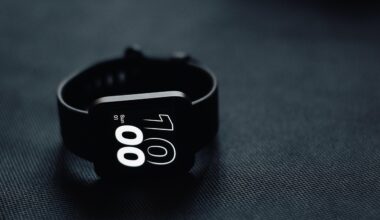Effective Warm-Up and Cool-Down Techniques with Exercise Bikes
Warming up is an essential part of any exercise routine, especially when using exercise bikes. A proper warm-up helps to prepare your body for the physical demands of cycling. Start with light pedaling at a slow pace for about 5 to 10 minutes. This gentle activity increases blood flow to your muscles and raises your heart rate gradually. Aim for a comfortable intensity; you should still be able to hold a conversation. After the initial five minutes, incorporate some dynamic stretching to further loosen up your body. Focus on your legs and hips, performing movements like leg swings or arm circles. Additionally, consider adjusting your bike seat height properly to improve comfort and minimize strain on your joints. Maintaining proper posture while cycling is also vital. Keep your back straight, and don’t hunch over the handlebars. Ensure your knees align with your feet to prevent injuries. Lastly, hydrate before your cycling session to keep your body operating effectively. A hydrated body can perform better and prevent muscle cramps during your workout, enhancing overall physical performance.
After your cycling workout, engaging in a cooldown is equally important. Gradually slow down your pace on the bike for 5 to 10 minutes to allow your heart rate to decrease safely. This gentle transition helps prevent blood from pooling in your lower extremities, reducing the chance of dizziness or fainting. Windows of low-intensity pedaling can be introduced in this phase, permitting essential recovery for your muscles. Incorporate static stretches after you complete the cooldown. Target major muscle groups such as quadriceps, hamstrings, calves, and glutes to alleviate tension. Hold each static stretch for at least 15 to 30 seconds, as this time is crucial for improving flexibility and maintaining muscle health. During the cooldown phase, remember to focus on controlled and deep breathing, as it helps to relax your body further. Concentrating on deep breaths can effectively slow down your heart rate and enhance oxygen flow to your muscles post-exercise. Utilize a foam roller if available, to release any muscle tightness and assist in recovery. Proper cooldown techniques are essential for better fitness results and faster recovery.
Benefits of Using Exercise Bikes for Warming Up
Utilizing exercise bikes as part of your warm-up has several significant benefits. One primary advantage is the ability to engage in low-impact cardiovascular activity. Cycling puts less strain on your joints compared to other forms of exercise, such as running or jumping. This makes it an excellent choice for individuals recovering from injury or those with joint issues. Exercise bikes allow you to control the intensity of your warm-up easily. By adjusting the resistance and speed, you can tailor the experience according to your fitness level and personal needs. Moreover, these bikes are particularly effective for targeting specific muscle groups, especially lower body muscles like quadriceps and hamstrings. With regular use, you’ll find improvements in your leg strength and endurance. Another benefit is the convenience of exercise bikes; they are widely available in gyms or can be easily purchased for home use. As an added bonus, many exercise bikes come equipped with features such as heart rate monitors or built-in workout programs that can enhance your overall experience.
Incorporating warm-up routines that focus on exercise bikes can lead to a more enjoyable workout experience. Through the familiarity and stability of a stationary cycle, users often feel more comfortable and confident, allowing for more effective workouts. Warm-ups on the bike can help establish a connection between your mind and body, preparing you mentally for the challenges ahead. Furthermore, these sessions help with muscle activation, promoting better coordination and movement patterns during your primary workout. A well-structured warm-up can also allow you to assess your physical state before your main exercise. If you feel any discomfort or pain, it’s important to address this before continuing with more strenuous activities. Lastly, performing a warm-up can set a positive tone for your workout. The gradual progression from low to moderate intensity allows for a more thorough transition, ensuring that you’re both mentally and physically prepared to tackle your exercise goals. Taking these few minutes to properly warm-up is not merely a routine but an investment in your overall fitness journey.
Key Considerations for Cool-Downs
While cooldowns are crucial for recovery, several key considerations can enhance their effectiveness when done after cycling. First, it’s essential to allow enough time for a proper cooldown; rushing this process can negate its benefits. Give a minimum of 5 to 10 minutes to gently lower your heart rate back to baseline levels. Pay attention to how your body feels; you might need longer if you exerted a high level of effort during your ride. Focus on keeping your movements slow and deliberate when transitioning from active cycling to complete rest. Also, consider integrating lower-body stretches targeting specific muscles worked during cycling; this minimizes soreness and optimizes flexibility. Incorporating upper body stretches is worthwhile too, as cycling can create tension in the shoulders and neck region. Ensure you breathe deeply throughout; controlled breathing during stretches fosters relaxation, promoting a better overall cooldown experience. Lastly, stay hydrated! Consuming water after exercise replenishes fluids lost during cycling and can significantly improve recovery, making your cooldown even more effective.
Understanding the differences between warm-ups and cooldowns is crucial for optimizing your workout with exercise bikes. A warm-up is designed to prepare your muscles and cardiovascular system for increased activity, whereas a cooldown is focused on gradually returning your body to its resting state. The physiological processes involved in both stages are distinct but equally essential. During warm-up, the goal is to increase your body temperature, enhance blood circulation, and activate muscle fibers, which prepares your body to handle more intense movements. In contrast, the cooldown allows for the progressive decrease of heart rate and promotes the removal of lactic acid build-up in the muscles. Recognizing these differences ensures that each part of your exercise routine serves its specific purpose, thereby maximizing your efforts and results. It is equally important to recognize personal preferences regarding warm-up and cooldown durations. Listen to your body and adjust the intensity if necessary for comfort and recovery. Ultimately, a tailored routine will lead to improved performance and enjoyment in exercise sessions.
Conclusion
In summary, effective warm-up and cooldown techniques using exercise bikes significantly enhance your overall fitness regimen. These practices not only prepare the body physically and mentally for exertion, but they also facilitate recovery and optimal performance. Prioritizing these steps can lead to improved strength, endurance, and flexibility, ultimately resulting in higher workout effectiveness. Warm-ups help activate your muscle groups while allowing for a gradual transition into higher intensity. On the other hand, cooldowns provide a necessary recovery process to prevent injuries and enhance muscle recovery. Additionally, utilizing a bike’s adjustable features makes personalizing your workout experience simple and accommodating. Do not skip these critical elements in your workout routine; they play a vital role in injury prevention and overall performance enhancement. Take the time to focus on your warm-up and cooldown strategies to harness the full benefits of cycling and maintain a better workout regimen for long-term success. Emphasizing the integration of effective warm-up and cooldown techniques will promote a healthier, more sustainable exercise routine, ultimately leading to improved overall fitness.
By incorporating a mix of techniques and being mindful of your body’s needs, you will become more aligned with your fitness goals. Consistency in practice will lead to stronger, more effective workouts, ensuring a balanced approach. Use exercise bikes as your primary tool for warming up and cooling down, gaining all the benefits from these essential practices. Cycling combines strength, endurance, and flexibility training, making it a comprehensive choice for effective workouts. Stay committed to your physical goals, and embrace the importance of comprehensive warm-up and cooldown practices to acquire a successful fitness journey.


